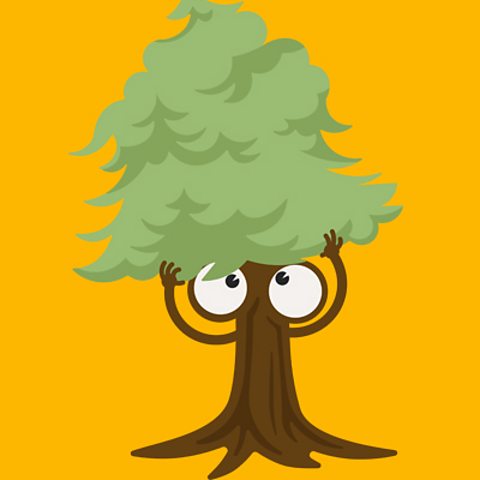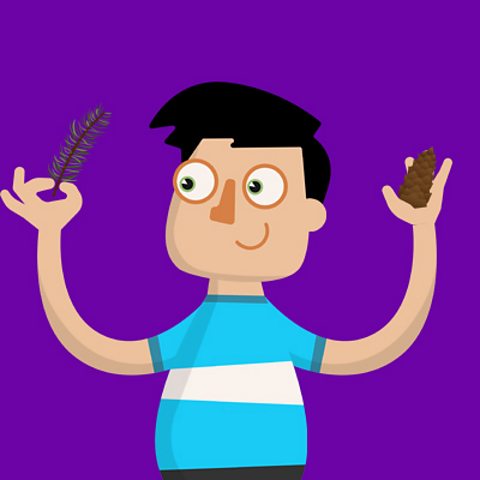In today's lesson
We're going to investigate the trees which grow on or around your school, and discover how much carbon they store. We'll develop our investigative skills and learn the skills we need to survey and record data accurately.
Introduction to the Trees Investigation
We asked Annabelle and Yousef from The Dumping Ground to visit Delamere Forest to learn about trees, how they store carbon and why this is important.
Annabelle Davis and Yousef Naseer investigate trees
Annabelle Davis:
Trees are such a familiar sight on our streets and parks. But you probably don't stop to think about how important they are to all our lives. But because you can't actually see all of the amazing things they're doing and trees don't tend to go around boasting about their talents.
Yousef Naseer:
But, if you take a closer look you'll find they're doing something quite extraordinary. They're actually helping to save our planet.
Annabelle Davis:
Trees are the superheroes of our natural world.
Yousef Naseer:
Trees play a really important part in keeping our planet healthy.
Annabelle Davis:
To find out more about their hidden super-powers, we've come to Delamere Forest in Cheshire to meet a terrific scientist, Doctor Cat Scott.
Yousef Naseer:
What do trees do that's so special?
Doctor Cat Scott:
Well you might've heard that trees give out the oxygen that we breathe.
Annabelle Davis:
And oxygen is really important to life on earth.
Doctor Cat Scott:
That's right. But just as important is the fact that they take a gas called carbon dioxide out of the air. Carbon dioxide is something called a "Green House Gas" which means when it's in the air, it's actually trapping heat around the earth. If there was no carbon dioxide the temperature of the earth would be far too cold for us to live on. But when we have too much that's bad becauseit starts to get too warm. So we need to keep a bit of a balance and trees can really help us with that as part of the carbon cycle.
Doctor Cat Scott:
All living things are made of carbon. But carbon is also found in the ocean, the air and rocks in the earth. It moves between these things and living things in a cycle. Plants and trees absorb carbon dioxide from the air and in turn animals feed on the plants and use the carbon to grow. When plants and animals breath and eventually die the carbon they've consumed is released and thecycle begins again. But humans have upset the delicate balance of the carbon cycle. By burning fossil fuels, carbon stored deep down in the earth to generate power and electricity, we're releasing lots more carbon dioxide into the air than ever before. This is causing the earth's atmosphere to heat up and contributing to climate change.
Annabelle Davis:
The trees play a vital role in fighting climate change by taking carbon dioxide out of the air through their leaves.
Yousef Naseer:
Many trees only grow and hold their leaves in the spring and summer months and these satellite images show what a difference they make at this time of year.
Doctor Cat Scott:
So at the moment this is the winter. We're seeing quite high concentrations
Yousef Naseer:
Wow.
Doctor Cat Scott:
of carbon dioxide. But as we move through into the summer, the trees will start to grow their leaves and start taking carbon dioxide out of the atmosphere and reduce the concentration.
Yousef Naseer:
By measuring the tree it's possible to estimate how much carbon it holds.
Annabelle Davis:
We want you to investigate how much carbon the trees in your school grounds are storing. Why is it so important for kids to find the carbon value of trees at their school?
Doctor Cat Scott:
So I think it's really surprising just how much carbon is stored in every tree like this and what we want to know is how much carbon all of the trees across schools in the UK are storing and how much schools are helping to fight climate change. We can estimate, based on the height of our tree and the circumference of the tree, that there's about three tons of carbon just in thisone tree alone.
Annabelle Davis:
Tons?
Doctor Cat Scott:
Tons, yeah. And that's why it's really important that we look after our forests.
Yousef Naseer:
As well as investigating the amount of carbon trees store, you'll learn about how they make a difference to the environment around us.
Annabelle Davis:
They also provide food and shelter for many birds and mini-beasts, like this guy here.
Yousef Naseer:
Where there's trees, there's wildlife.
Annabelle Davis:
And we're meeting up with Adam Makin from the Cheshire Wildlife Trust to try and find some. How do you trees support wildlife?
Adam Makin:
Um, so trees are actually incredibly important for wildlife. So down amongst the roots you'll get things like wood mice making little holes and living down there. Going up through the trunk you might get beetles and beetle larvae that feed on the bark. And then up into the canopy the caterpillars, midges uh, flies, butterflies, moths all those kinds of things providing a banquet for thingslike birds and bats.
Yousef Naseer:
Even in the cold winter months the trees still help keep the forest full of life.
Adam Makin:
So this branch here, obviously fallen off and died
Yousef Naseer:
Yeah.
Adam Makin:
but it might be a great place for mini-beasts.
Annabelle Davis:
Yeah.
Adam Makin:
Just roll this over. Do you want to hold it? Then we'll put him back when we're done. There we go, we've got a millipede.
Yousef Naseer:
Wow!
Adam Makin:
So he'll be eating the leaves that have come off the tree. He might even eat some of the dead wood from the log itself.
Annabelle Davis:
Oh, oh! [SCREAMS] Look on my hand.
Yousef Naseer:
Spending the day amongst these majestic trees has been awe inspiring.
Annabelle Davis:
From giving us the air we breathe to surrounding us with the beauty of nature, trees are incredible things.
Yousef Naseer:
They are really are nature's super-heroes.
Annabelle Davis:
If we look after the trees, they'll look after us.
How to do the Trees Investigation
This short film contains a step-by-step guide to completing the Trees Investigation.
How to do the Trees investigation
Narrator:
For this investigation, each group will need chalk, string, scissors, measuring tape, a student recording sheet, pens, a 30cm ruler, plastic wallets, labels, a tree identification sheet, and a carbon calculator sheet. Before you begin the investigation, you should consider, is the area around the tree clear from obstacles, such as bushes, bins and bollards? Is the area around the tree asafe distance from roads? Are the trunks easy to access? Please refer to the lesson plan for guidance. Use chalk to number each tree in the area you are going to survey. Divide the class into small groups, and allocate each group one of more trees to investigate. Each group should note down the number of the tree they are surveying. Part one, measure the circumference. Use thechalk to mark one side of your tree 130cm from the bottom of the trunk. Mark the other side of your tree at the same height. Hold one end of the string against the first chalk mark. Wrap the string tightly around your tree. Make sure it passes along the second chalk mark. Mark the string where it meets. Measure the length of your string from the end to the mark. This is thecircumference. Part two, measure the height. Pupil one should stand facing the tree and hold up the ruler at arms length, with the 30cm mark at the top. With the help of pupil two, pupil one walks carefully backwards, looking through the ruler, until they can see the top of the tree as in line with the 30cm mark, and the bottom of the tree trunk is level with 0cm mark. It's importantpupil one holds this position with the ruler at arms length for the next few steps. Pupil three stands next to the tree and points their hand at the side of the tree near the ground. Guided by pupil one, pupil three moves their hand until it is level with the 3cm line on the ruler. Mark the tree at this height. Measure the height of the new mark. Multiply this measurement by ten to getthe height of the tree. Collect evidence to identify your tree. This could be leaves, fruit, seeds, buds, flowers, or a photograph. Label the evidence with the tree's number and your names. Repeat this process for every tree that you survey. Pupils should wash their hands afterwards. Part three, find out your results. Use the tree identification sheets, alongside your evidence, toclassify the trees you have surveyed. You can now use the appropriate carbon calculator worksheet and your data to work out the carbon value of each tree. Collate all the pupils' results to work out the total carbon value of the trees in your survey. Refer to the lesson plan for guidance.
Investigating trees
Trees are really important for many reasons, and you are going to discover why.
In this investigation you are going to:
- Survey as many of the trees on your school site as you can
- Record how tall they are, and the circumference of their trunks
- Examine the trees for anything unusual and make a note of your findings
- Use a carbon calculator to work out how much carbon each tree is storing
- Calculate the total amount of carbon stored by all the trees at your school
- Discover why trees storing carbon is important and where the carbon comes from
Have fun!


